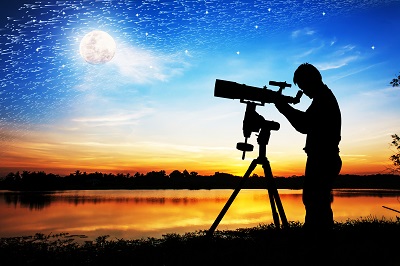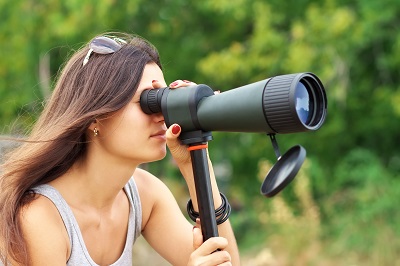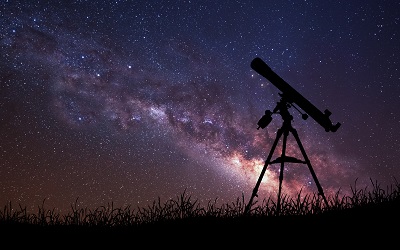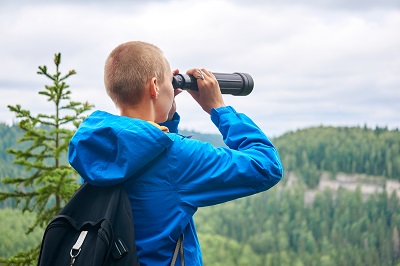A spotting scope and telescope are fantastic pieces of equipment to view distant objects close up. But choosing between a Telescope Vs. Spotting Scope can be tricky. Telescopes are typically the go-to tool for astronomy, and spotting scopes are preferred for bird watching, hunting, or surveillance. However, there are types of scopes that are good all-rounders.

The choice of buying a spotting scope or telescope comes down to the main reason for using one. This guide to buying a quality scope will help you determine which type is best for you. At the end of the article, you will know which optical instrument best suits your needs.
Spotting Scope Vs. Telescope — An Overview
A spotting scope (also called a spotter) is a versatile tool that is best used for terrestrial viewing—in other words, land objects. However, some high-quality spotting scopes are suitable for amateur astronomy. Telescopes give a better view of the sky but are less portable and durable than spotting scopes.
To know if a telescope or spotting scope is best, understanding how each piece of viewing equipment works is crucial.
What Is A Spotting Scope?
A spotting scope is a small, modified telescope designed for viewing objects up close. The scope uses a combination of lenses to gather light and focus images. The size of the lens and the magnification power determine the quality of the image. A spotter is more powerful than binoculars and less powerful than a telescope.
Other things you should know about a spotting scope is that it has a single eyepiece, should be mounted on a tripod, and typically has standard magnification between 30x and 60x.
What Is A Telescope?
A telescope is an optical tool that uses curved mirrors or lenses to view distant objects. Like the spotting scope, the telescope uses a series of lenses to gather light, magnify objects, and keep them in focus. A refracting telescope uses lenses, whereas a reflecting telescope uses mirrors.
Telescopes typically must be mounted on a special tripod. Depending on the level of magnification required, a telescope can be a large piece of equipment with wide lenses to let in more light.
How To Use A Spotting Scope

Let’s look at how a spotting scope works to understand how to use it.
Spotting scopes tend to have a magnification strength of 30x to 40x, sometimes up to 60x. Magnification of anything above 60x usually results in blurry images. Additionally, factors like heat waves, dust particles, and air currents will affect the image quality. Spotters also have variable zoom, which is difficult to find on telescopes.
Spotters are also better at viewing objects that are not “astronomical” distances away. This is a reason why scopes are typically used for terrestrial viewing. In addition, because the scopes are highly portable and generally waterproof, they are ideal for taking outdoors.
Therefore, spotting scopes are the best buy if you like watching wildlife, hunting, or digiscoping—using a digital camera to take video or photos through a telescope.
Here is a list of some of the uses for a spotting scope:
- Surveillance
- Hunting
- Birdwatching
- Digiscoping
- Target shooting
- Basic astronomy
Pros And Cons Of A Spotting Scope
Pros Of Spotting Scopes
- Portable and rugged design for outdoor use
- Provides excellent images in low light
- Short-range viewing of moving objects
- Perfect for taking photos with a digital camera
- Superior power and zooming capabilities compared to binoculars
- More straightforward to adjust zoom magnification than a telescope
- Unlike telescopes, images always appear the right way up
Cons Of Spotting Scopes
- Magnification over 60x can appear blurry
- Moisture can affect lenses (especially on cheap spotting scopes)
- Not designed for serious astronomers
- More eye fatigue than using binoculars
How To Use A Telescope
Buying a telescope is the logical choice for anyone serious about astronomy viewing. Whether purchasing a refracting scope or a reflecting scope, a telescope can provide close-up images of objects hundreds or thousands of miles away. First, however, you may be wondering if a telescope is a good choice for terrestrial viewing.

Telescopes are designed with powerful lenses to let in maximum light. Then, through a series of lenses or mirrors, the scope can produce clear images of objects in the night sky. Even with a decent telescope or good mid-range telescope, you can get powerful magnification ranges between 90x and 150x.
However, the high zoom magnification is why most outdoor enthusiasts choose a spotter rather than a telescope. Telescopes are not great at magnifying images in a relatively short range. One factor is that the closer an object, the blurrier the image will be.
The way an image appears through a telescope also helps determine how to use it. For example, a reflector telescope flips images vertically. So, if you are bird watching, the birds will be flying upside down. On the other hand, a refractor telescope flips images horizontally, making the object appear backward. However, image orientation is not an issue when stargazing, looking at the moon, or observing an eclipse.
Therefore, telescopes are better for celestial viewing. Here is a list of reasons to buy a telescope:
- Viewing the moon and planets in the solar system
- Amateur and professional astronomy
With additional accessories, there are several other ways to use a telescope. Here they are:
- Astrophotography
- Birdwatching
- Digiscoping
Pros And Cons Of A Telescope
What are the primary considerations before deciding whether to buy a telescope or not? Here are a few pros and cons.
Pros Of Telescopes
- Maximum light exposure to produce detailed images
- High magnification to view deep-sky objects
- High power lenses
- Perfect for astronomy
- High precision instruments
Cons Of Telescopes
- Less portable and durable
- Changing zoom levels can be difficult
- More expensive than spotting scopes
- Images appear upside down or backward
- Not suitable for rugged outdoor use
Telescope Vs. Spotting Scope
By now, you should have a clearer idea if a spotting scope or telescope is the best choice. To help choose between the two, you can use the 80/20 rule. So, whatever you plan on using the scope for 80 percent of the time—this is your choice.
For example, suppose you want a quality optical instrument for bird or wildlife watching. And you plan to use the scope for at least 80 percent of the time. In that case, a high-quality spotting scope is an obvious choice. However, if looking into the night skies is your passion, a telescope is the best purchase.
Using A Spotting Scope For Astronomy

How can you choose a spotting scope suitable for land-viewing and occasional stargazing? First, you should look for a scope with a magnification of 60x and a large objective lens. For example, 60x magnification power and an 80mm to 100mm objective lens will allow you to see the moon, some planets, clear stars, and meteors.
The other consideration when buying a spotting scope for astronomy is the eyepiece. It’s best to choose a spotter with a scope lens angled at 45°. This makes it easier to look at the skies with the scope on a tripod.
Telescope Vs. Spotting Scope — In Conclusion
The choice of telescope or spotter depends on what kind of activities you plan to do with your new equipment. If you enjoy observing wildlife, camping, or hunting, then a spotting scope is the best choice. And, you can also use it for entry-level astronomy. However, you plan to spend your time looking at faraway objects, a telescope is probably right for you.

